#liturgical garment
Photo


Today’s Flickr photo with the most hits: an example of the rich embroidery that decorates the 14th CE dalmatic, from Whalley Abbey, which is housed in the Burrell Collection.
#dalmatic#whalley abbey#burrell collection#museum#holy family#glasgow#embroidery#deacon#liturgical garment
1 note
·
View note
Text
I made a mistake in a post some little while ago when I was talking about Copia's papa robe.


I said the black and gold design was an unused version of it and that the blue version won. What I failed to realise is that the black piece was never meant to be the whole costume, it was simply meant to go over the blue robe. We do have that piece of costume.
Fun fact, it's called a cope and it's a piece of liturgical wear. They're extremely ornate garments that can be worn by any rank of the clergy (real clergy not "Message from the Clergy" clergy). Here's the costume with :

And here's the costume without :


Just wanted to clarify that, okay bye!
#the band ghost#ghost bc#papa emeritus the fourth#papa iv#papa copia#copia#meerkat talks about ghost costumes
179 notes
·
View notes
Text
FWIW if anyone wants to know the terminology for Cardi's various vestment layers- a labeled picture with lots of words, my additions in purple
I made this in 2021, and as far as I know the terminology is accurate. Or if it's not, no one's ever told me 😅 I was going to reblog my original post but just reposting mg own work takes less time

So, starting from the top:
-Copia's mitre (pope hat) is covered in jewels, which led me to believe it is a specific type of mitre- the pretiosa mitre. According to Wikipedia "The pretiosa ('precious') is decorated with precious stones and gold and worn on the principal Mass on the most solemn Sundays (except in Lent) and feast days." You can see how big the jewels are in RITE HERE RITE NOW during "Call Me Little Sunshine."
-The black thing I see a lot of you calling a cloak is technically a mantum. Again, from Wikipedia: "The mantum is longer than a cope [the cope or "rain coat" is a shorter garment with a less elaborate clasp], and is fastened in the front by an elaborate morse. In earlier centuries it was red, at the time the papal colour. In the 11th and 12th centuries the immantatio, or bestowal of the mantum on the newly-elected pope, was regarded as specially symbolical of investiture with papal authority. After the Second Vatican Council and the pontificate of Pope Paul VI, the mantum fell out of use."
-The elaborate clasp that holds the mantum on is called, among other things, a morse. According to some Catholic encyclopedia I found, "The brooch or clasp, meant to fasten the cope [or mantum] in front, and variously called morse, pectoral, bottone, etc., was an object often in the highest degree precious and costly. The work which was the foundation of all the fortunes of Benvenuto Cellini was the magnificent morse which he made for Pope Clement VII."
-The blue garment is the chasuble. Every Papa wore a chasuble- except Papa Nihil, oddly. I need to analyse Papa Nihil's fit some day... Anyway, not much to say about Copia's chasuble except, from my reading, blue is typically NOT used for chasubles. Blue is a colour reserved for depictions of the Virgin Mary, traditionally, iirc. Copia's colour is also on the outside of his chasuble, which is opposite of how Papa II and III's chasubles were- Papa II's had a black outside and green lining, Papa III's had a black outside and purple lining. Copia's colour being on the outside had me thinking it was a visual signifier that he was not "of the bloodline." I was wrong obvs. Still an interesting choice!
-The scarf thing is a stole. Not much to say about it. From the Catholic encyclopedia: "A liturgical vestment composed of a strip of material from two to four inches wide and about eighty inches long. It has either a uniform width throughout, or is somewhat narrower towards the middle, widening at the ends in the shape of a trapezium or spade." Early concept art from one of the designers showed the stole read (something) DIVINI DRACONE or something to that effect, translating to THE DIVINE DRAGON. Maybe Papa V will use that...

I have forgotten who did this art and I hope it's not considered in bad taste to post it. You can see the idea of the mantum here, too. In RITE HERE RITE NOW you can see the jewels that run down the back.
#the band ghost#ghost bc#ghost the band#papa emeritus iv#frater inperator#rite here rite now#rhrn#ghovie
39 notes
·
View notes
Text
Sunday sounds: Palm Sunday. Revolution
As it did during Advent, this page is going to walk with its readers this last stride towards Easter, for the entire Holy Week. If this is not your jam, please ignore these posts. Even if this blogger is Catholic, the focus here is on personal thoughts, not doctrine. And everyone is welcome.
Many things are celebrated in remembrance, this Sunday, and since this is a 'B' liturgical year, we do have Mark's reporter-like version to meditate upon. All the events and all the critically important people for what is bound to happen next week are presented to us, along with the apparent denouement.
But first, there's the Jerusalem Crowd and its spontaneous, instinctive Joy: 'and many spread their garments in the way: and others cut down branches off the trees, and strawed them in the way' (Mark, 11:8). The poorest of the poor are now placed, by the course of events, upfront and centerstage. And never forget: this is what we piously call 'the Classical World', where these people do not have a voice, nor a message. History was never written by them: it simply served to keep track of and eternally praise the military campaigns of despots. This Joy is nothing short of revolutionary.
youtube
Some of this energy is melancholically translated in this old Transylvanian Palm Sunday Carol. It reminds us of the Dawn of a New World, we often seem to totally forget about.
50 notes
·
View notes
Text

Old chasuble, liturgical garment circa 1880.
Iconography of the pelican piercing its chest with its beak to feed its young.
Very beautiful work of embroidery with gold threads and fringes.
Silk on linen, presented in its original state with its usual wear and tear which gives it so much charm.
Old School Bazaar
42 notes
·
View notes
Text
Veiling is not about Modesty (and it can even be Immodest)
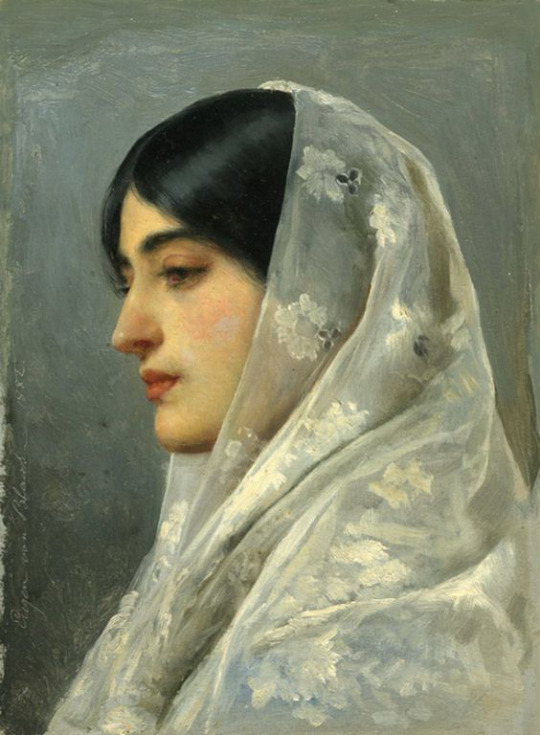
What is the purpose of Veiling? If you were to look at some other religions, the answer you would get is "modesty". To discuss veiling, we must first discuss Modesty and "modesty". The idea goes, the more of the body covered = the more modest it is. But Christianity (and especially Eastern Orthodox Christianity) is much different than any other religion in the world. Thus, our view on Modesty is much different.
Modesty, in our faith, is not about being covered in the Worldly sense; it is about blending in and going unnoticed. This is where the middlingly correct idea of the "heart posture" comes into play(1). It is hypothetically possible to clad oneself in an ankle-length floral dress and a lovely veil and still be immodest if one is doing it with the intention of attracting the attention of pious men. It is always immodest to dress in a way that provokes, intentionally or unintentionally, such as overly flashy clothing or jewelry, or dress that is very foreign to the culture where you are visiting or residing. Likewise, it is also possible to be modest in a garment that leaves the wearer nearly naked, as in a swimsuit at the beach, where that is the expected attire.
The actual purpose of the Veil, especially in a Prayerful or Liturgical setting, is an expression of a portion of our Theology of the Church, the Eucharist, and Jesus. The Church is a woman, a Wisdom to whom all Priests and Bishops are married. All Orthodox Christians are the bride of Christ, though the men and women among us express this truth in different ways. The Eucharist is, theologically, the fruit of the marital union between the celebrant and the Church. Our Christian theology, down to its very core, is marital. The veil is marital garb.
The primary pieces of scripture Christians cite in favor of Veiling are 1 Corinthian's 11:5, " But every woman that prayeth or prophesieth with her head uncovered dishonoureth her head: for that is even all one as if she were shaven," (KJV), and 1 Thessalonians 5:16-18, "Rejoice evermore. Pray without ceasing. In every thing give thanks: for this is the will of God in Christ Jesus concerning you," (KJV). Taken together, many would say that women must, at least, cover their hair/heads in Church and during prayer in general. Many would further say that this implies women should veil all the time, or at least in public.
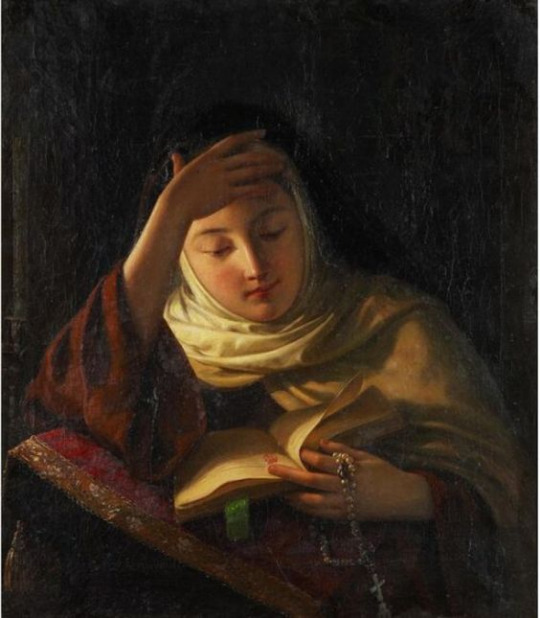
But why is that? Is a woman's hair immodest? Is it indecent to show one's hair or head in public? Fortunately, no. No part of the body in Christianity is considered intrinsically indecent or shameful. On the contrary-- every part of the body is valuable and good, and it is only the Fall that brings shame upon them. What is indecent and what is acceptable is determined by the society you find yourself in. If we find ourselves in a community that believes elbows are the height of inflammatory sexuality, I should hope we all cover them with only the thickest of wool shrouds.
In the Old Testament, a woman covering her hair is a symbol of marriage, first and foremost. This is not only true in the Hebraic culture of the OT, but also in most antique cultures across the Middle East and the Mediterranean both in the OT, and in the Gospels and the Epistles. Unlike what many young Orthodox women say, the veil is not a symbol of submission, either-- at least not any more than a wedding ring is today or the veil of Hebrew women was. The veil of a Christian woman is the expression of a theological truth-- wearable ecclesiology and Christology.
1) Much of the discussion of heart posture, especially in protestant circles, is simply an excuse to wear crop tops to Church in the name of personal piety. Another post on this shall follow. A good rule of thumb is that heart posture always condemns, never excuses.
#eastern orthodoxy#christianity#orthodox christianity#eastern orthodox#christian#modesty#veiling#veil#Christian modesty#christian girl#christian blog#woman of god#feminine modesty
9 notes
·
View notes
Photo

An Ordinator's every action must reflect the divinity of the Tribunal. Every thought, word, and gesture, no matter how trivial, must glorify the Three. Our appearance, too, must bring honor to ALMSIVI. Herein you shall find a guide to liturgical vestment.
At the beginning of the vesting, an Ordinator must wash herself thoroughly, using mineral water from one of Red Mountain's sacred hot springs and a volcanic pumice. This act has profound spiritual significance. In washing the body, the Ordinator also washes the soul—removing residual sin and any nagging doubts that might interfere with the merciless application of Tribunal law.
Once the washing is complete, the proper vesting can begin.
The Ordinator begins with the rathith—triangular linen small clothes, dyed a deep blue and fastened with brass pins. The rathith is further secured by the arnith, the golden "underbelt" which is also secured using brass pins. Daughters of ALMSIVI are also permitted to wear the alrathith, a second garment tailored to support the breasts.With the rathith and alrathith secured, the Ordinator is free to move on to the llananor, or "second garment." This long shirt must be washed in sacred mineral water before the sun rises, and pressed thrice over a hot stone. When donning the llananor, the Ordinator must also recite the Litany of Three Virtues. If the Ordinator completes the litany before the shirt is fully donned, they are obliged to repeat the litany twice more before moving on to the next step of the vesting.
The Ordinator's pants, or felassani, must also be washed and thrice pressed before wearing. Ordinators should put on these trousers starting with the left foot and must fasten them using a blue, rope-like belt called a nosa. The slippers must likewise be worn starting with the left foot, and laced with gold ribbon.
Finally, the Ordinator must drape a crimson wool stole, or duleso, about the neck and shoulders thrice, and fasten it with a triangular golden reliquary clasp—a neleviso. This ends the first vesting, or llanathro'lani, and prepares the Ordinator for armor-suiting.Before the holy armor can be donned, the Ordinator must recite the Forty-Six Canticles of Supplication, and appeal to St. Nerevar the Captain, patron of warriors and defender of Dunmeri society, for protection. After receiving Nerevar's blessing, the Ordinator begins armor inspection.
The Armor of Triune Faith must be free of any nicks, dents, stains, corrosion, or other aesthetic imperfections. Even minor blemishes are affronts to ALMSIVI's divine persons. Ordinators found wearing imperfect armor shall be subject to severe sanction.
The polish should be thorough and uniform, but not garish. The chitinous undervest must be rubbed with an oiled cloth and flexed to prevent aging and distress. Furthermore, the Ordinator should oil all joints, and treat all leather with a firm brushing and a liberal application of kwama-wax armor dressing. At this point, the Ordinator should signal an initiate to prepare for armor fitting.
The initiate begins with the sabatons and greaves (starting with the left) while reciting a prayer to St. Rilms, patron of pilgrims. Once this devotional is complete, the initiate proceeds to the cuisses, reciting another prayer to St. Meris, patron of laborers. At this point, the Ordinator must anoint the breastplate with sacred mineral oil and recite another prayer of supplication to blessed St. Nerevar before handing it over to the initiate. After fastening the cuirass, the initiate moves on to the rerebraces and couters, reciting another devotional to St. Aralor the Penitent. After securing and lacing the pauldrons, the inititate should glove the Ordinator, starting with the left gauntlet, all the while reciting a prayer to St. Delyn the Wise. Finally, the initiate must drape the blue prayer stole, or retheles, over the warrior's shoulders, reciting a final prayer to St. Felms the Bold. This accomplished, the assistant is permitted to retreat to the chapel for post-vesting prayer.
Final armor preparations are left to the Ordinator herself. Using the left hand, the Ordinator must tuck a sprig of bittergreen beneath her right pauldron. Using the right hand, the Ordinator must trace the sign of the Tribunal on her chest—gnashing her teeth and hissing thrice, at each point of the triune to summon up the wrath of the Tribunal. The tinder of faith thus kindled, the Ordinator anoints the Golden Mask of Devotion with mineral oil, presses her forehead to the helm to likewise anoint herself, then dons the helm. Ordinators may now arm themselves with any weapon, so long as it is thoroughly cleaned, and thrice blessed before use.
At this point, any action of the Ordinator is protected by divine mandate. So long as she wears the mask, the Ordinator is considered a faultless hand of the Three, and is authorized to commit any martial action deemed necessary to protect the True Faith. Hands of Almalexia and other specialized members of the order may have additional vestments to wear, but any servant of the Three thus vested is considered a full Ordinator.
Keep to this guide, stay earnest in your prayers, and you will bring naught but glory to ALMSIVI.Victory for the Three.
--A Guide to Liturgical Vestments
205 notes
·
View notes
Text

19th June >> Mass Readings (USA)
Wednesday, Eleventh Week in Ordinary Time
or
Saint Romuald, Abbot.
Wednesday, Eleventh Week in Ordinary Time
(Liturgical Colour: Green. Year: B(II))
First Reading
2 Kings 2:1, 6-14
A flaming chariot came between them, and Elijah went up to heaven.
When the LORD was about to take Elijah up to heaven in a whirlwind, he and Elisha were on their way from Gilgal. Elijah said to Elisha, “Please stay here; the LORD has sent me on to the Jordan.” “As the LORD lives, and as you yourself live, I will not leave you,” Elisha replied. And so the two went on together. Fifty of the guild prophets followed and when the two stopped at the Jordan, they stood facing them at a distance. Elijah took his mantle, rolled it up and struck the water, which divided, and both crossed over on dry ground.
When they had crossed over, Elijah said to Elisha, “Ask for whatever I may do for you, before I am taken from you.” Elisha answered, “May I receive a double portion of your spirit.” “You have asked something that is not easy,” Elijah replied. “Still, if you see me taken up from you, your wish will be granted; otherwise not.” As they walked on conversing, a flaming chariot and flaming horses came between them, and Elijah went up to heaven in a whirlwind. When Elisha saw it happen he cried out, “My father! my father! Israel’s chariots and drivers!” But when he could no longer see him, Elisha gripped his own garment and tore it in two.
Then he picked up Elijah’s mantle that had fallen from him, and went back and stood at the bank of the Jordan. Wielding the mantle that had fallen from Elijah, Elisha struck the water in his turn and said, “Where is the LORD, the God of Elijah?” When Elisha struck the water it divided and he crossed over.
The Word of the Lord
R/ Thanks be to God.
Responsorial Psalm
Psalm 31:20, 21, 24
R/ Let your hearts take comfort, all who hope in the Lord.
How great is the goodness, O LORD,
which you have in store for those who fear you,
And which, toward those who take refuge in you,
you show in the sight of the children of men.
R/ Let your hearts take comfort, all who hope in the Lord.
You hide them in the shelter of your presence
from the plottings of men;
You screen them within your abode
from the strife of tongues.
R/ Let your hearts take comfort, all who hope in the Lord.
Love the LORD, all you his faithful ones!
The LORD keeps those who are constant,
but more than requites those who act proudly.
R/ Let your hearts take comfort, all who hope in the Lord.
Gospel Acclamation
John 14:23
Alleluia, alleluia.
Whoever loves me will keep my word,
and my Father will love him
and we will come to him.
Alleluia, alleluia.
Gospel
Matthew 6:1-6, 16-18
And your Father who sees what is hidden will repay you.
Jesus said to his disciples: “Take care not to perform righteous deeds in order that people may see them; otherwise, you will have no recompense from your heavenly Father. When you give alms, do not blow a trumpet before you, as the hypocrites do in the synagogues and in the streets to win the praise of others. Amen, I say to you, they have received their reward. But when you give alms, do not let your left hand know what your right is doing, so that your almsgiving may be secret. And your Father who sees in secret will repay you.
“When you pray, do not be like the hypocrites, who love to stand and pray in the synagogues and on street corners so that others may see them. Amen, I say to you, they have received their reward. But when you pray, go to your inner room, close the door, and pray to your Father in secret. And your Father who sees in secret will repay you.
“When you fast, do not look gloomy like the hypocrites. They neglect their appearance, so that they may appear to others to be fasting. Amen, I say to you, they have received their reward. But when you fast, anoint your head and wash your face, so that you may not appear to others to be fasting, except to your Father who is hidden. And your Father who sees what is hidden will repay you.”
The Gospel of the Lord
R/ Praise to you, Lord Jesus Christ.
------------------------
Saint Romuald, Abbot
(Liturgical Colour: White. Year: B(II))
(Readings for the memorial)
(There is a choice today between the readings for the ferial day (Wednesday) and those for the memorial. The ferial readings are recommended unless pastoral reasons suggest otherwise)
First Reading
Philippians 3:8-14
I continue my pursuit toward the goal, the prize of God’s heavenly calling, in Christ Jesus.
Brothers and sisters: I consider everything as a loss because of the supreme good of knowing Christ Jesus my Lord. For his sake I have accepted the loss of all things and I consider them so much rubbish, that I may gain Christ and be found in him, not having any righteousness of my own based on the law but that which comes through faith in Christ, the righteousness from God, depending on faith to know him and the power of his resurrection and the sharing of his sufferings by being conformed to his death, if somehow I may attain the resurrection from the dead.
It is not that I have already taken hold of it or have already attained perfect maturity, but I continue my pursuit in hope that I may possess it, since I have indeed been taken possession of by Christ Jesus. Brothers and sisters, I for my part do not consider myself to have taken possession. Just one thing: forgetting what lies behind but straining forward to what lies ahead, I continue my pursuit toward the goal, the prize of God’s upward calling, in Christ Jesus.
The Word of the Lord
R/ Thanks be to God.
Responsorial Psalm
Psalm 131:1bcde, 2, 3
R/ In you, Lord, I have found my peace.
O LORD, my heart is not proud,
nor are my eyes haughty;
I busy not myself with great things,
nor with things too sublime for me.
R/ In you, Lord, I have found my peace.
Nay rather, I have stilled and quieted
my soul like a weaned child.
Like a weaned child on its mother’s lap,
so is my soul within me.
R/ In you, Lord, I have found my peace.
O Israel, hope in the LORD,
both now and forever.
R/ In you, Lord, I have found my peace.
Gospel Acclamation
Matthew 5:3
Alleluia, alleluia.
Blessed are the poor in spirit,
the Kingdom of heaven is theirs!
Alleluia, alleluia.
Gospel
Luke 14:25-33
Any one of you who does not renounce all his possessions cannot be my disciple.
Great crowds were traveling with Jesus, and he turned and addressed them, “f anyone comes to me without hating his father and mother, wife and children, brothers and sisters, and even his own life, he cannot be my disciple. Whoever does not carry his own cross and come after me cannot be my disciple. Which of you wishing to construct a tower does not first sit down and calculate the cost to see if there is enough for its completion? Otherwise, after laying the foundation and finding himself unable to finish the work the onlookers should laugh at him and say, ‘This one began to build but did not have the resources to finish.’ Or what king marching into battle would not first sit down and decide whether with ten thousand troops he can successfully oppose another king advancing upon him with twenty thousand troops? But if not, while he is still far away, he will send a delegation to ask for peace terms. In the same way, everyone of you who does not renounce all his possessions cannot be my disciple.”
The Gospel of the Lord
R/ Praise to you, Lord Jesus Christ.
6 notes
·
View notes
Text



image 1: a black cassock with a clerical collar.
image 2: a white alb, a long liturgical garment like a dress.
image 3: a white cinture, a woven rope with a tassel on either end. It is tied loosely for storage.
#christianity#clothing#clothes#vestments#cassock#alb#cincture#communication symbol#communication image#aac symbol#aac image#aac emoji#custom emoji
9 notes
·
View notes
Text
Today is Pentecost, which is when we commemorate the descent of the Holy Spirit upon Jesus' disciples after his ascent into Heaven. According to the book of Acts, this was accompanied by miraculous events, including prophecies by all classes of people and the ability to speak and understand many different languages.
In iconography, this moment is portrayed with the Holy Spirit (usually depicted in the form of a dove) coming down through holy rays on the assembled crowd. A flame burns above each person's head, symbolizing the indwelling of the Holy Spirit in every individual, and the spiritual gifts and powers that we can access through the Holy Spirit in us.
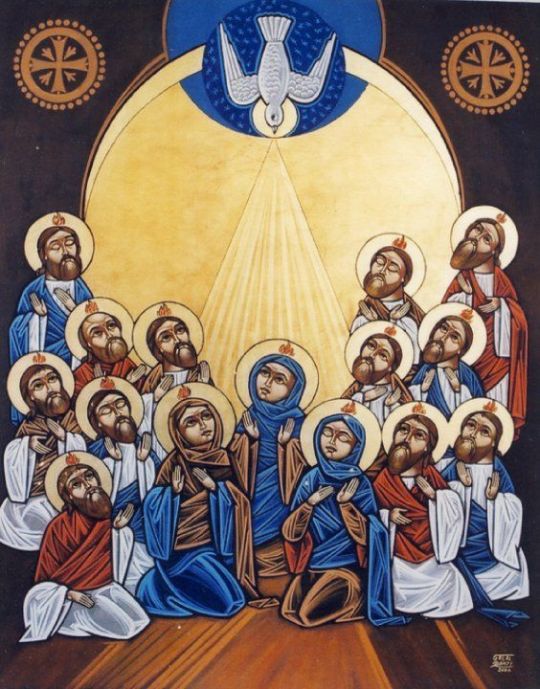
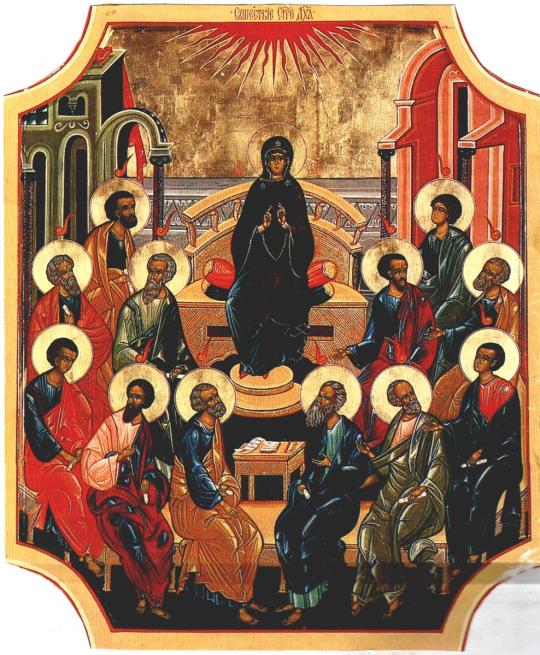
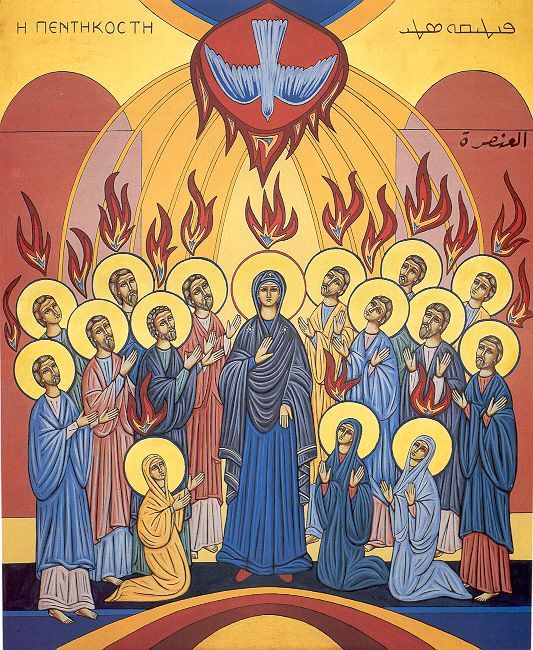
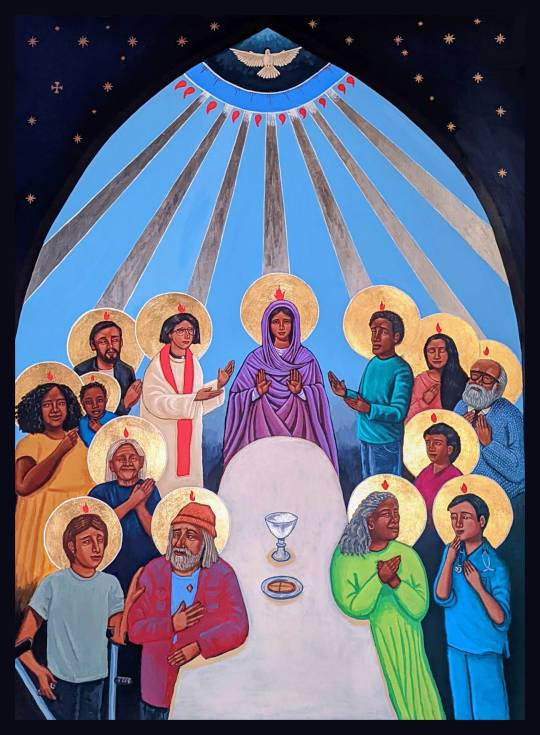
There are also a few features in the liturgy that are unique to the celebration of Pentecost. This was ours:
youtube
The songs, readings, sermon, and a few of the liturgical prayers focus on the significance of the Holy Spirit and what the Pentecost narrative means in the context of when it was written. The vestments and drapery are red, symbolizing fire, passion, blood, and the "burning" of the Holy Spirit within us. (Insert children's hospital joke here.) Red is a powerful color, and is only used during a few special feasts and celebrations throughout the year. This is a lively and joyous celebration, and it's traditional for people to wear red, which you can see on a few members of the congregation. Yellow, orange, and "fire/wind" symbolism are also used. We had banners depicting the Holy Spirit in dove form at the front of the nave. I was the one responsible for ringing the bell during the Eucharist, and I rang it EXTRA VIGOROUSLY, for which I got several compliments. The fire-colored cut roses in vases around the altar were donated to the church and distributed to members of the congregation after the service.
The medieval-looking red cloak that the celebrant is wearing in the opening procession is called a cope, which is worn on special occasions in the Western Church. It comes to us from a style of raincoat or warm outer garment that was worn in antiquity. Today they're normally worn by bishops, and the celebrating priest is the only one of our clergypeople who is tall enough for the one we have at our church.
Not related to Pentecost but interesting anyway: the woman in the gray robe leading the procession and presiding over the liturgy is called the verger, which is an office that is unique to Anglicanism. The verger is the boss and stage manager of the liturgy, and has a few other roles in the management of the church. The staff they carry is a symbol of their authority, and historically was used to push animals or unruly children out of the way. They are always a layperson. Having a layperson in this liturgical role symbolizes the importance of laypeople in Anglicanism, and reminds us that professional clergy derive their authority from the consent of the governed.
37 notes
·
View notes
Text
On today's episode of "Meerkat is so normal about Ghost costumes, I swear I'm normal I DON'T HAVE A PROBLEM."
Let's swatch Terzo's papa robe!

And the tunic he has under.
Now this is going to be about showcasing the more detailed fabrics on his garment, so I will not be covering things like the lining of his robe. Disclaimer done, let's get into it.
First of, the robe itself! Liturgical satin brocade. At first I thought it was embellished with just gold sequins but upon closer inspection HOLY SHIT THERE'S A TINY SKULL INTO THEM
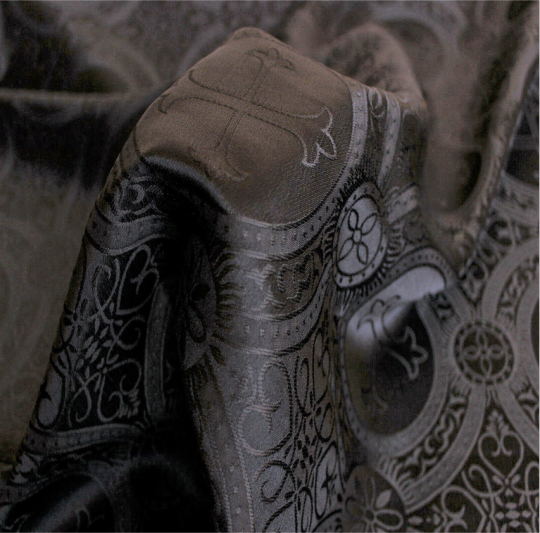

The center panel is a type of guipure lace, that same pattern is also used on the bottom of his tunic, but in gold instead of black.
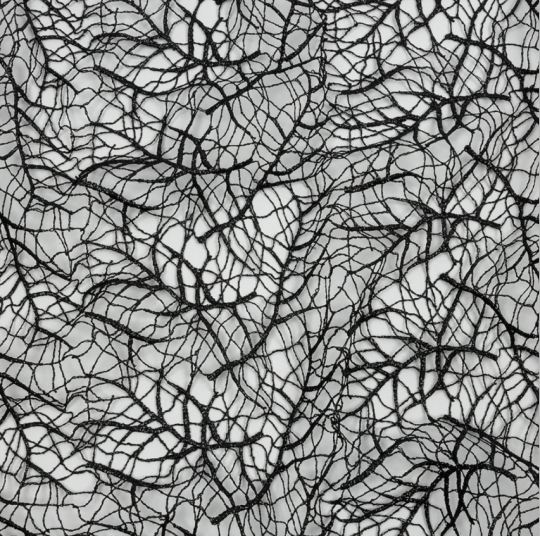

The sleeves of the tunic use a different kind of guipure lace, lined some kind of golden brocade.

The hem and the front panel are adorned with a very basic lace trim.

I'll probably do this again with other costumes because this is fun :3 anyways, good evening ghulehs!
#the band ghost#ghost bc#terzo#papa emeritus lll#papa emeritus the third#papa terzo#ghost terzo#meerkat talks about ghost costumes#meerkat swatches Ghost
125 notes
·
View notes
Text
Saint John begins his account of how Jesus washed the feet of his disciples with especially solemn, almost liturgical language: "Before the feast of Passover, Jesus knew that his hour had come to pass from this world to the Father. He loved his own in the world and he loved them to the end" (13:1). The "hour" of Jesus has arrived, toward which all of his activity was directed from the beginning. John describes what makes up the content of this hour with two terms: "to pass" (metabainein, metabasis) and "agape" – love. These two words explain each other; both describe together the Passover of Jesus: cross and resurrection, crucifixion as elevation, as "passage" to the glory of God, as a "passing" from the world to the Father. It is not as if Jesus, after a brief visit to the world, were now simply departing and returning to the Father. This passage is a transformation. He carries with him his flesh, his being man. On the Cross, in giving himself, He is fused and transformed, as it were, into a new mode of being, in which He is now forever with the Father, and at the same time with men. He transforms the Cross, the act of killing, into an act of self-donation, of love to the end. With this expression, "to the end," John refers in advance to the last words of Jesus on the Cross: all has been brought to conclusion, "it is finished" (19:30). Through his love, the Cross becomes "metabasis," the transformation of the human being into a participant in the glory of God. In this transformation, He involves all of us, drawing us into the transformative power of his love to such an extent that, in our being with Him, our lives become a "passage," a transformation. Thus we receive redemption – becoming participants in eternal love, a condition toward which all of our existence strives.
This essential process of the hour of Jesus is represented in the washing of the feet, in a sort of symbolic prophetic action. In it, Jesus displays through a concrete action precisely what the great Christological hymn of the letter to the Philippians describes as the content of the mystery of Christ. Jesus removes the garments of his glory, he girds himself with the "towel" of humanity, and becomes a slave. He washes the dirty feet of the disciples and thus makes them capable of participating in the divine meal to which He invites them. Exterior purifications for worship, which purify man ritually while nevertheless leaving him as he is, are replaced by the new bath: He makes us pure through his word and his love, through the gift of himself. "You are already pruned because of the word that I spoke to you," He will say to the disciples in his discourse on the vine (John 15:3). He continually washes us again with his word. Yes, if we welcome the words of Jesus in an attitude of meditation, of prayer and of faith, they develop their purifying power within us. Day after day, we are as it were covered with various forms of uncleanness, empty words, prejudice, partial and altered wisdom; a multifarious half-falsity or open falsity constantly infiltrates our depths. All of this obfuscates and contaminates our soul, it threatens to make us incapable of truth and goodness. If we welcome the words of Jesus with an attentive heart, these reveal themselves as genuine washings, purifications of the soul, of the inner man. This is what the Gospel of the washing of the feet invites us to: to allow ourselves continually to be washed again by this pure water, to allow ourselves to be made capable of convivial communion with God and with our brothers. Yet from the side of Jesus, after the blow of the lance from the soldier, there emerged not only water, but also blood (John 19:34; cf. 1 John 5:6,8). Jesus did not only speak, He did not leave us only words. He gives himself. He washes us with the sacred power of his blood, meaning his self-donation "to the end," to the Cross. His word is more than simple speech; it is flesh and blood "for the life of the world" (John 6:51). In the holy Sacraments, the Lord kneels down again and again before our feet, and washes us. Let us pray to Him that the sacred bath of his love may penetrate us more and more deeply, so that we may be truly purified!
If we listen attentively to the Gospel, we can discover two different aspects in the episode of the washing of the feet. The washing that Jesus performs for his disciples is above all simply his own action – the gift of purity, of the "capacity for God" offered to them. But the gift then becomes a model, the task of doing the same thing for each other. The Fathers described this twofold aspect of the washing of the feet with the words "sacramentum" and "exemplum." In this context, "sacramentum" does not refer to one of the seven sacraments, but to the mystery of Christ in its totality, from the incarnation to the cross and resurrection: this totality becomes the healing and sanctifying power, the transformative power for men, it becomes our "metabasis," our transformation into a new form of being, in openness toward God and in communion with Him. But this new being that He, without our merit, simply gives to us must then be transformed in us into the dynamic of a new life. The totality of gift and example that we find in the pericope of the washing of the feet is characteristic of the nature of Christianity in general. In comparison with moralism, Christianity is something more and something different. Our activity, our moral capacity is not placed at the beginning. Christianity is above all a gift: God gives himself to us – He does not give some thing, but himself. And this takes place not only at the beginning, at the moment of our conversion. He continually remains the One who gives. He always offers us his gifts anew. He always precedes us. For this reason, the central action of being Christians is the Eucharist: gratitude for having been gratified, the joy for the new life that He gives us.
In spite of all this, we do not remain passive recipients of the divine goodness. God gratifies us as personal and living partners. The love that is given is the dynamic of "loving together," it is intended to be a new life within us, beginning from God. We thus understand the words that, at the end of the account of the washing of the feet, Jesus speaks to his disciples and to all of us: "I give you a new commandment: love one another. As I have loved you, so you also should love one another" (John 13:34). The "new commandment" does not consist in a new and difficult norm, one that did not exist before. The new commandment consists in a loving together with Him who loved us first. This is also how we must understand the Sermon on the Mount. This does not mean that Jesus gave us new precepts at that time, which represented the demands of a more sublime humanism than the previous one. The Sermon on the Mount is a journey of training in conforming ourselves to the sentiments of Christ (cf. Philippians 2:5), a journey of interior purification that leads us to living together with Him. The new reality is the gift that introduces us into the mentality of Christ. If we consider this, we perceive how far we often are in our lives from this new reality of the New Testament; how slight an example we give to humanity of loving in communion with his love. We thus owe humanity a proof of the credibility of Christian truth, which is demonstrated in love. Precisely for this reason, we desire all the more to pray to the Lord to make us, through his purification, ripe for the new commandment.
In the Gospel of the washing of the feet, the conversation between Jesus and Peter presents yet another detail of the praxis of Christian life, to which we finally want to turn our attention. At an earlier point, Peter had not wanted to allow the Lord to wash his feet: this reversal of order, that the master – Jesus – should wash feet, that the master should perform the service of a slave, is completely in contrast with his reverential fear of Jesus, with his concept of the relationship between teacher and disciple. "You will never wash my feet," he tells Jesus in his usual passionate manner (John 13:8). This is the same mentality that, after the profession of faith in Jesus as Son of God, in Caesarea Philippi, had urged Peter to oppose Jesus when he had predicted his affliction and cross: "No such thing shall ever happen to you," Peter had declared categorically (Mt. 16:22). His concept of the Messiah involved an image of majesty, of divine greatness. He had to learn over and over again that the greatness of God is different from our idea of greatness; that it consists precisely in descending, in the humility of service, in the radicalness of love to the point of total self-abandonment. And we, too, must learn this over and over again, because we systematically desire a God of success, and not of the Passion; because we are not capable of realizing that the Shepherd comes as a Lamb who gives himself, and in this way leads us to the right pasture.
When the Lord tells Peter that without the washing of his feet he would never be able to have any part in Him, Peter immediately and impetuously asks to have his head and hands washed as well. This is followed by the mysterious words of Jesus: "Whoever has bathed has no need except to have his feet washed" (John 13:10). Jesus alludes to a bath that the disciples, according to ritual prescriptions, had already taken; in order to participate in the meal, they now needed only to have their feet washed. But naturally, a deeper meaning is hidden in this. To what does it allude? We do not know for sure. In any case, we should keep in mind that the washing of the feet, according to the meaning of the entire chapter, does not indicate a single specific Sacrament, but the "sacramentum Christi" in its entirety – his service of salvation, his descent even to the cross, his love to the end, which purifies us and makes us capable of God. Here, with the distinction between the bath and the washing of feet, nevertheless, there also appears an allusion to life in the community of the disciples, to life in the community of the Church – an allusion that John may have intentionally transmitted to the community of his time. It then seems clear that the bath that purifies us definitively and does not need to be repeated is Baptism – immersion in the death and resurrection of Christ, a fact that changes our lives profoundly, giving us something like a new a identity that endures, if we do not throw it away as Judas did. But even in the endurance of this new identity, for convivial communion with Jesus we need the "washing of the feet." What does this mean? It seems to me that the first letter of Saint John gives us the key for understanding this. There we read: "If we say, 'We are without sin,' we deceive ourselves, and the truth is not in us. If we acknowledge our sins, he is faithful and just and will forgive our sins and cleanse us from every wrongdoing" (1:8ff.). We need the "washing of the feet," the washing of our everyday sins, and for this we need the confession of sins. We do not know exactly how this was carried out in the Johannine community. But the direction indicated by the words of Jesus to Peter is obvious: in order to be capable of participating in the convivial community with Jesus Christ, we must be sincere. One must recognize that even in our own identity as baptized persons, we sin. We need confession as this has taken form in the Sacrament of reconciliation. In it, the Lord continually rewashes our dirty feet, and we are able to sit at table with Him.
But in this way, the word takes on yet another meaning, in which the Lord extends the "sacramentum" by making it the "exemplum," a gift, a service for our brother: "If I, therefore, the master and teacher, have washed your feet, you ought to wash one another's feet" (John 13:14). We must wash each other's feet in the daily mutual service of love. But we must also wash our feet in the sense of constantly forgiving one another. The debt that the Lord has forgiven us is always infinitely greater than all of the debts that others could owe to us (cf. Mt. 18:21-35). It is to this that Holy Thursday exhorts us: not to allow rancor toward others to become, in its depths, a poisoning of the soul. It exhorts us to constantly purify our memory, forgiving one another from the heart, washing each other's feet, thus being able to join together in the banquet of God.
Holy Thursday is a day of gratitude and of joy for the great gift of love to the end that the Lord has given to us. We want to pray to the Lord at this time, so that gratitude and joy may become in us the power of loving together with his love. Amen.
Benedict xvi
5 notes
·
View notes
Text


Reflections 🪞
Composition inspired by Caravaggio’s Narcissus. Bonus material is Lewerentz in vestments (priest variations + deacon), I love liturgical garments and the ritualistic aspects of religious practice.
Instagram // Twitter // Threads // Bluesky // VK // Cara // Mastodon
#artists on tumblr#sigurd lewerentz#markuskyrkan#stockholm#sweden#illustration#architecture#brutalism#churches#st mark’s church#st mark’s stockholm#dark academia#dark academia aesthetic#swedish church#svenska kyrkan#vestments#cyhsal
6 notes
·
View notes
Text
On the Types of Cassock Robes
Consider yourself well-educated and worldly if you can even recognize a cassock robe and are not affiliated with the clerical assembly.
These unique clerical garments are common enough, but not well-known among laypeople.
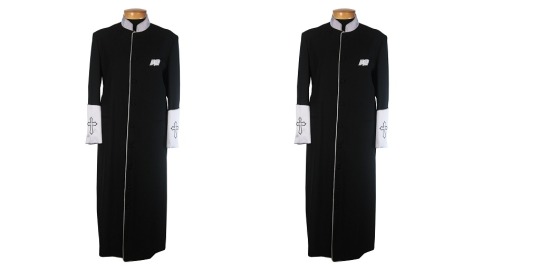
Believe it or not, there are actually three distinct styles, as follows.
Anglican Cassock Robes
The main difference between an Anglican cassock and a Roman cassock (see below) is the addition of two pleats along the front and back of the robe.
Another difference is that sometimes the Anglican-style cassock is worn without a cincture (although this is not always the case).
Black is the most common color, but in warmer locations white is sometimes common, as are themed colors associated with changes in the liturgical calendar.
Roman-Style Cassocks
There is more than one style of Roman cassock, but the main traits in common among them are the inclusion of two pleats along the back as well as an opening at the front.
Roman-style cassocks were often made with buttons that communicated the wearer’s rank. Traditionally, they have been made with 33 buttons (along the front) which symbolize the 33 years of Jesus’ life.
They are also commonly worn with tab-collared clergy shirts that are commonly worn by priests in the Catholic church.
Choir Cassocks
Finally, we have the choir cassock, which is an integral part of choir dress. Sometimes, choir cassock robes are sleeveless and intended to be worn with a clergy collar shirt underneath them.
Oftentimes, colored cassocks are also referred to as choir cassocks.
Who Wears a Cassock?
Cassocks are typically worn by priests. Though they are often worn in conjunction with other robes during the officiation of a ceremony, unlike other vestments “proper,” cassock robes can be worn at other times of the day and when not engaged in official duties.
This makes cassocks sort of like the “everyday habit” of the priest. They may also be worn by other choir members.
Where Can I Find Quality Cassocks & Robes Online at Good Prices?
When shopping for high-quality cassock robes, one of the most important things to be aware of is sizing. You’ll need not only your size but your length to ensure you get a cassock that fits.
It’s also important to ensure you shop with a company that is well-respected in the industry for the quality of its products. Consider Divinity Clergy Wear, online at DivinityClergyWear.com.
They carry a wide range of clergy cassocks, clerical attire, and accessories, including clergy shirts, in a wide range of colors and styles.
Their vestments and clerical garments exhibit high quality, are available in extended sizes, and are available with robe bags to protect their garments in transit and storage.
In addition to its website, Divinity Clergy Wear welcomes its potential customers to come and visit them in their showroom in Hamilton, New Jersey.
Their showroom is conveniently located about halfway between New York and Philadelphia and offers excellent resources for getting familiar with their clergy robes.
Consult their site for more details or contact them directly at 609-838-7154.
2 notes
·
View notes
Text
Vestments Decoration
Discover exceptional vestments decoration at Istok Church Supplies, where tradition meets artistry. Our collection of vestment decorations blends timeless elegance with meticulous craftsmanship, enhancing the sacred beauty of your liturgical garments. From intricately embroidered designs to exquisite button accents, each piece is thoughtfully crafted to reflect your spiritual devotion and elevate your worship experience. Our range includes a variety of styles, from classic to contemporary, ensuring a perfect match for your church's aesthetic. Explore our selection to find the ideal adornments that embody grace and reverence, and bring an added layer of dignity to your vestments. Trust Istok Church Supplies to provide quality and beauty that stand the test of time.
0 notes
Text
In the 1720s, the use of albs, a long white linen vestment with sleeves worn by priests and others, in pools was a controversial topic. Many people questioned the practicality and safety of wearing such a garment in a swimming pool setting. However, despite the criticism, albs continued to be worn by clergy and other religious figures while swimming.
One of the main reasons for the use of albs in pools was due to their religious significance. Albs have been a part of Christian liturgical vestments for centuries and are seen as a symbol of purity and holiness. For priests and other religious figures, wearing albs in the pool was a way to honor their faith even while engaging in a recreational activity.
Another reason for the use of albs in pools was their practicality. In the 1720s, swimming was not a common activity for most people. It was primarily seen as a form of exercise or a recreational activity for the wealthy. At this time, pools were not like the ones we see today, with smooth tiled floors and walls. They were often made of rough stone or pavers, which could be uncomfortable to walk on with bare feet. Albs, with their long hemlines, provided protection for the legs and feet while moving around the pool. They also provided additional coverage for modesty, which was highly valued in society at the time.
Moreover, albs were also made of sturdy and absorbent linen material, which made them ideal for swimming. In a time where regularly washing one’s clothing was not as easy or accessible as it is today, linen was a practical choice for a garment that would regularly be exposed to water and sweat. It was also lightweight and easy to move around in, making it suitable for swimming.
Some may argue that wearing albs in a pool could be a safety hazard, as the garment could become easily waterlogged and hinder movement. However, this concern was not as significant in the 1720s as it may be today. Most swimming pools were relatively shallow, and lifeguards were not common at the time. In addition, swimming strokes were less advanced, and the style of swimming was more leisurely. Drowning incidents were relatively rare, so the perceived danger of wearing albs in the pool was not a significant concern.
In conclusion, albs in the 1720s were commonly worn in pools by priests and other religious figures for their religious significance, practicality, and modesty. They were made of suitable material for swimming and provided protection and coverage in a time where modesty and hygiene were highly valued. While some may have viewed the practice as unusual, it was ultimately a personal choice and one that did not pose significant safety hazards at the time.
0 notes